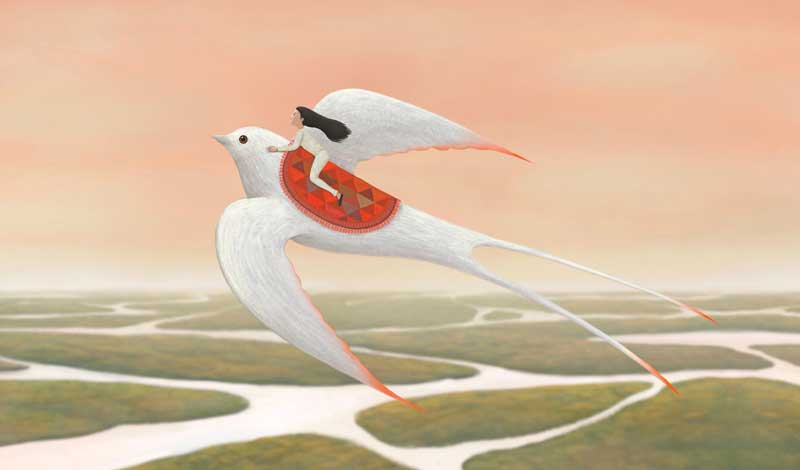The natural human response to suffering is often despair. But Buddhism teaches that it is precisely in such times that the human spirit can reveal its greatest strength.
In his 2014 peace proposal, Ikeda Sensei spoke about Malala Yousafzai, a Nobel Peace laureate and young Pakistani activist who became an international icon for promoting girls’ education after surviving an assassination attempt by the Taliban. In her speech at the U.N. Headquarters in July 2013, she expressed her unwavering resolve:
Nothing changed in my life except this: weakness, fear and hopelessness died; strength, power and courage were born. … I am the same Malala. My ambitions are the same, my hopes are the same, my dreams are the same.[1]
How can we embody this same spirit—to not only remain unshaken by our current reality but also to bring forth the courage and hope required to continue challenging the situation at hand until we transform it?
Sensei writes about the kind of hope that enabled Mahatma Gandhi to lead the nonviolent struggle for Indian independence: “His hope was not based on circumstances, rising and falling as things seemed to be getting better or worse. Rather it was based on an unshakable faith in humanity, in the capacity of people for good. He absolutely refused to abandon his faith in his fellow human beings.”[2]
Having faith in the inherent goodness of others and unceasingly cultivating that goodness in ourselves are keys to unleashing the power of hope in our lives. Sensei explains:
Hope, in this sense, is a decision. It is the most important decision we can make. Hope changes everything, starting with our lives. Hope is the force that enables us to take action to make our dreams come true. It has the power to change winter into summer, barrenness to creativity, agony to joy. As long as we have hope, there is nothing we cannot achieve. When we possess the treasure of hope, we can draw forth our inner potential and strength. A person of hope can always advance.[3]
This understanding of hope as an act of will, a courageous stand in the face of fundamental delusion, lies at the heart of Sensei’s philosophy of Buddhist humanism. Hope, in this sense, is a revolutionary act—one capable of transforming ourselves, our circumstances and the world.
Given that hope is the starting point for everything, let’s talk about how to create it.
The Courage to Battle Within
Ikeda Sensei in his guidance to young people recalled a passage he had engraved in his heart as a youth: “If you want to conquer the world, conquer your despair.”[4] Creating hope, especially in challenging times, begins with breaking through within.
Buddhism teaches that the same power that moves the universe exists within our own lives and the immense potential that we each possess has the power to transform everything—our own suffering, the lives of others and, ultimately, the environment in which we live. This all hinges on our inner determination.
Sensei says:
When we change our inner determination, everything begins to move in a new direction. The moment we make a powerful resolve, every nerve and fiber in our being will immediately orient itself toward the fulfillment of this goal or desire. On the other hand, if we think, “This is never going to work out,” then every cell in our body will be deflated and give up the fight.[5]
How Can We Create Hope?
1. Start With Prayer
In the realm of faith, everything starts with praying to the Gohonzon. Sensei says: “Faith is a spiritual struggle against doubt, against a wavering mind. It is the struggle to break through delusion and lack of confidence—which make us think we cannot become happy or that we are hopeless. It is to bring the power of the Mystic Law to well forth from within and establish absolute conviction.”[6]
Chanting Nam-myoho-renge-kyo brings forth the sun of hope from our lives and produces tremendous life force. Sensei encourages us: “When you are suffering, chant daimoku. When you are stuck, chant daimoku. If you do, life force and courage will emerge, and you will be able to change your situation. Our Buddhist practice is the engine for victory in all things.”[7]
2. Learn From Our Mentor’s Example
When we feel lost or confused, it is important to seriously delve into Buddhist study so that we can view our problems through the eyes of the Buddha. Sensei says:
You will no doubt come up against all sorts of difficulties in your lives. At such times, you may wonder why this happens even though you are chanting or why your wishes do not come true.
That’s when I would like you to read Nichiren’s words. By studying his writings, you come into contact with the life of Nichiren Daishonin. You are bound to feel courage, wisdom and hope well up from within.
Then with a renewed vow and earnest prayer, you can face your situation head-on.[8]
3. Refresh Our Vow
In “The Dragon Gate,” Nichiren Daishonin writes: “My wish is that all my disciples make a great vow.”[9] In declaring his own vow, Nichiren famously declares: “This I will state. Let the gods forsake me. Let all persecutions assail me. Still I will give my life for the sake of the Law. … Here I will make a great vow. … I will be the pillar of Japan. I will be the eyes of Japan. I will be the great ship of Japan. This is my vow, and I will never forsake it!”[10]
From a societal standpoint, Nichiren was an exile. However, nothing could restrain his indomitable spirit. Sensei reminds us that those who understand their mission for kosen-rufu can tap into the power to transform every poison into medicine, creating enduring personal narratives that can be a source of hope for others: “Breaking the shackles of denial, powerlessness and apathy requires a deep sense of mission and commitment based on a personal vow.”[11]
Youth: The Torchbearers of Hope
Throughout his life, Sensei placed enormous trust in youth. He wrote countless essays, poems and encouragement addressed to young people, urging them to believe in their dreams and to see themselves as agents of change. “In every age,” he says, “it is the passion and power of youth that has changed the times and created history.”[12]
Hope Begets Hope
Creating hope is not naive. It is bold. It is revolutionary. And perhaps, most importantly, it is contagious. Hope begets hope.
Sensei reminds us: “There may be times when, confronted by cruel reality, we verge on losing all hope. If we cannot feel hope, it is time to create some. We can do this by digging deeper within, searching for even a small glimmer of light, for the possibility of a way to begin to break through the impasse before us.”[13] By tapping into that inner strength, we can create hope—not only for ourselves but for others as well.
When we take this courageous step—to fundamentally believe in others and in the possibility of change in our personal lives and in the world—and to act on that belief, we become beacons of hope in a world that desperately needs light.
Change Starts With Believing It Is Possible
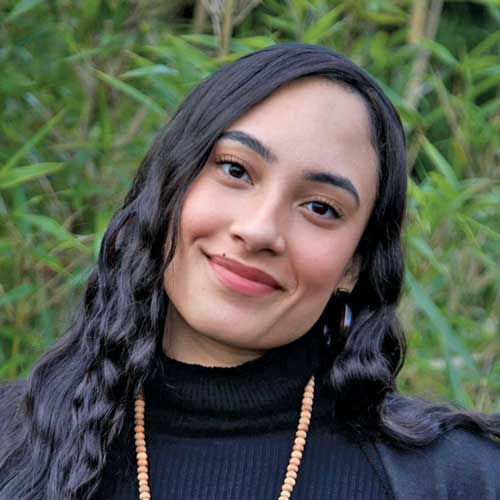
Mikai Arion / Portland, Oregon
Living Buddhism: Mikai, thank you for sharing your story with us. First, can you talk a little bit about your childhood?
Mikai Arion: I was born in Oakland, California, to a family that practices Nichiren Buddhism with the SGI. When I was 9, my family moved to a majority white suburb in the Bay Area. This is when I began chanting Nam-myoho-renge-kyo to help me navigate racism and microaggressions with bravery, and I began appreciating my Buddhist practice. This came to a head in high school, when I was wrongly accused of a crime I didn’t commit. Through my Buddhist practice and with my family’s support, the case was dismissed, and my record and name were cleared. It was after this actual proof that I decided to receive the Gohonzon at 17, before leaving for college in Portland, Oregon.
What was your experience like in college?
Mikai: I was excited for a new adventure, but at my predominantly white college and city, I was confronted by poverty driven by racism, gentrification and even KKK rallies. I felt my heart growing cold, and I actively withdrew from dialogue and interaction with white people, spending most of my time with the few Black students on campus. My isolation, mistrust and negativity toward others was growing.
One day in history class, my professor pulled down a large screen and projected a life-size image of a lynched Black man hanging from a tree. She described it as art and asked the class to analyze the image. I was paralyzed with shock. My friend, noticing my discomfort, asked for the image to be removed, but the professor refused.
That night, I chanted fervently for the man in the photo and for myself. I realized that I could no longer live with hatred in my heart.
Can you explain what you mean by that?
Mikai: It was a battle between being taken in by my emotions and using the strategy of the Lotus Sutra. I was angry and wanted to harbor hatred for this professor, run away from dialogue and feel hopeless about the future of society.
I realized that in my actions, while it felt empowering to say I didn’t need to interact with certain kinds of people, when I was alone, I felt empty and unhappy. I was lost and was, ultimately, running away from my mission.
After this incident, I chanted and went back to Ikeda Sensei’s guidance and Nichiren Daishonin’s writings. I chanted to see my life clearly and polish it. I wanted to transform this and know what my mission was. I wanted to make the most profound positive impact that I could for those around me and my society.
In his dialogue on education, Sensei says:
Abandoning dialogue is tantamount to abandoning our trust in humanity. All that remains then is the logic of force. Violence and force breed hatred and retaliation, from which arises more violence, permanently preventing peacebuilding. (Living as Learning, p. 191)
What did that quote mean to you?
Mikai: Because this situation was in my environment, I knew it was part of my mission to transform it. Even if I couldn’t bring forth empathy for the professor, I wanted to ensure that I could do my part to ensure that no future student would have to experience the same thing.
The professor was put on behavioral leave, but when she returned, I scheduled a meeting with her and the dean. In that meeting, I shared my heart, the true historical context of the image and why sharing a photo of murder as art was inappropriate. I also shared Nam-myoho-renge-kyo with her and my Buddhist perspective on honoring the sanctity of human life. To my surprise, she was receptive, and we ended up sharing a meaningful conversation. After this, I felt a shift in my life.
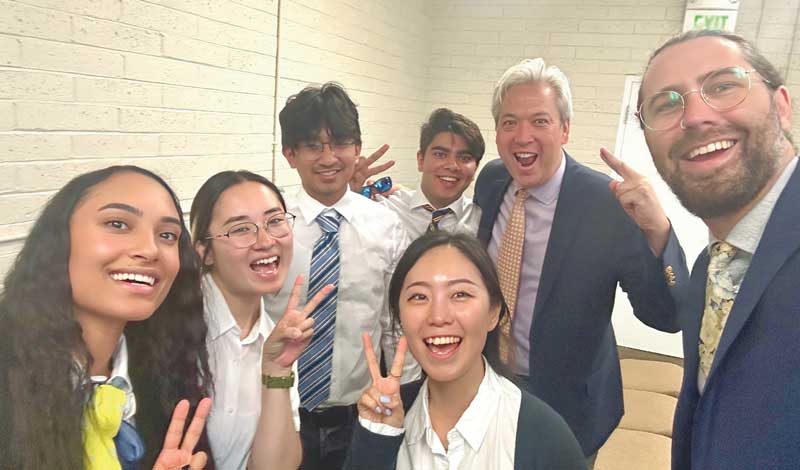
How did Sensei’s words encourage you to take that action?
Mikai: When I paired chanting with Sensei’s guidance, I could see what tangible actions I could take to change my environment. In front of the Gohonzon, I had to fight against the urge to retreat. Through studying, I knew that I had to take responsibility for my life and that chanting would provide me with the wisdom, courage, compassion and energy to solve these issues and create value.
There are many youth who feel hopeless about the world they live in and want to retreat. What do you think about that?
Mikai: It’s only natural. There is a lot going on. I think it’s easy to feel hopeless when things don’t seem to change or we feel the weight of history. But Buddhism teaches the infinite power of the individual. Whatever causes we make, big or small, are shifting things on a level that we can’t fathom.
If we think about any goal in life, we start small and chip away at the goal until we achieve it. But if we never start, then we will never know if it was possible. We will constantly live with regret. That’s something I learned from Sensei. We want to look back at the life we lived and be proud of how hard we exerted ourselves for others.
I also think it’s important to band together with like-minded people in the spirit of “many in body, one in mind.” When we try to create change alone, it can feel heavy and impossible. But imagine if 10,000 people each took just one step together. That kind of collective action can ripple out and transform the world. On the flip side, if those same 10,000 people sat back and did nothing, thinking their efforts didn’t matter, progress would stall before it even began. For example, sharing Buddhism on my own is meaningful—but when 10, 20, or 30 people all start sharing it too, the impact grows exponentially.
How do you create hope?
Mikai: I have so many tools in my toolbox because of my Buddhist practice!
The first is prayer. Chanting the words Nam-myoho-renge-kyo is so profound. When I’m deadlocked and I sit in front of the Gohonzon, I am immediately lifted up. I can sit, cry, feel anger, but when I finish chanting, my life condition is elevated, and that allows me to cut through the clouds of emotion. Youth are passionate with a lot of physical and mental energy. But if that energy is not channeled through prayer, we can become overwhelmed or misguided by people and other things in life.
The other way I create hope is through planting seeds of the Mystic Law. When I explain Buddhism to someone else, it reinvigorates my life because I feel like I’m actually reintroducing myself.
The third way I create hope is through reading Sensei’s and Nichiren’s guidance. Their words always direct me back to the right path.
And finally, supporting others through the Byakuren Group has been a life-changing experience for me. It’s an opportunity to band together with other young women and be trained on how to protect our community, both inside and outside the SGI. The mission of the Byakuren is so profound. We are taking responsibility to help transform society by caring for and protecting those around us.
If you have a toolbox of things you can pull from to create hope, you will never be at a deadlock. And then you can teach others how to create hope so that no one is ever stuck in the cycle of feeling hopeless.
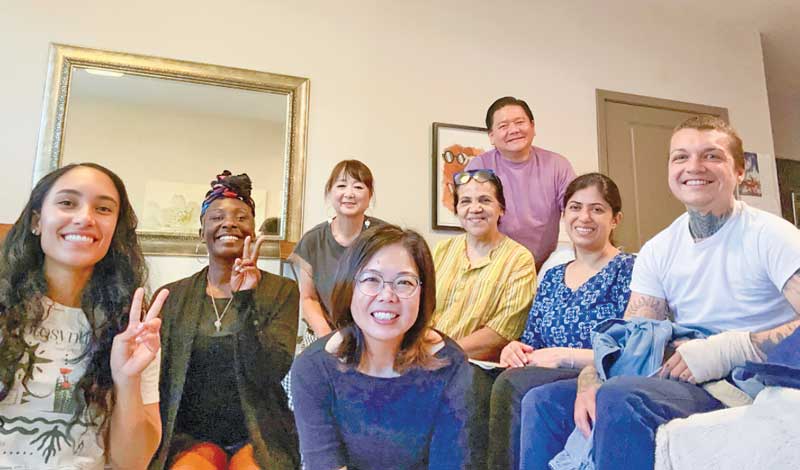
What is hope to you?
Mikai: As Sensei says, hope is a decision. Maybe this is strict, but we can wallow in self-pity and hopelessness, sadness, anger, judgment or self-righteousness all day, but at some point we have to make an active decision to find hope. If we are in a dark tunnel, we can decide, I am going to be the light. There are millions of experiences of people in the SGI deciding that whatever odds are against them, they were going to make the impossible possible, and they did!
We can either let the world sweep us up or put a stake in the sand and say, I’m going to rise up and help other people do the same thing. Especially regarding the world around us, having hope that things can change is so important. Sensei says:
Firm motivation for “human revolution” and “optimism” based on absolute confidence in humanity, combined with the “dialogue of civilizations” carried on in the spirit of such motivation and optimism—these, I believe, are what will enable humankind to free itself from the darkness of our time pervaded by nihilism. (Global Civilization, p. 175)
That’s very powerful. What is your determination for the future?
Mikai: I am an artist and herbalist. By 2030, I’m determined to have a happy family that works for kosen-rufu and raise children within the SGI. My goal is to also have a farm, where I tend the land and where people can come rewild themselves and practice reciprocity with healing plants. I believe that many of the ills of society start from devaluing the essential sources that sustain our breath, life and vitality—like Mother Earth. I will also continue sharing Buddhism and supporting others so that I can do my part in making my part of the world better.
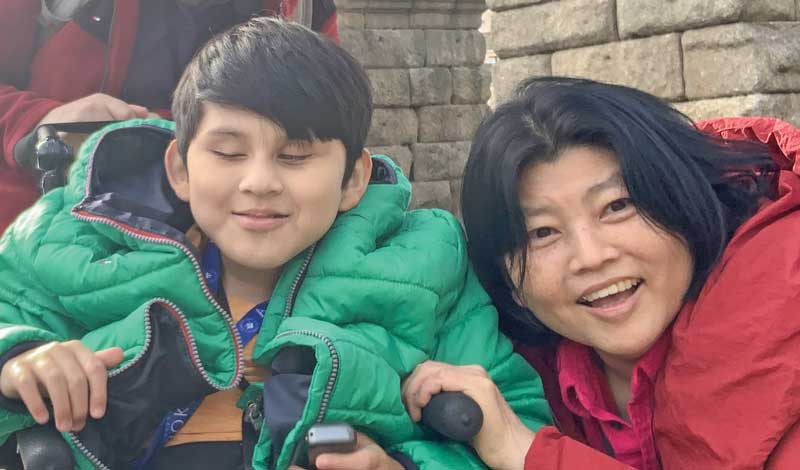
‘Opening Our Eyes’ to Our Mission
Myeong and Jason Hasson / Fresno, Calif.
Living Buddhism:Thank you for sharing about how your family created hope during a challenging time. Can you tell us about when your second son, Jason, was born?
Myeong Hasson: Soon after Jason was born, he was diagnosed with persistent hyperplastic primary vitreous, meaning his eyes were not fully developed. We were told that, unless surgery could correct it, Jason would be blind.
On the drive home from that doctor’s appointment, my husband, Alam, was crying, and my mind was blank. Alam later shared that he was filled with fear for Jason, not knowing what the future held for him. I don’t know what I was feeling. I had been practicing Buddhism since I was 8. I wondered how this could be a benefit.
What did you do?
Myeong: I went straight to the Gohonzon and opened The Writings of Nichiren Daishonin. Before we received this diagnosis, Nichiren’s letters were just letters. But in this situation, I approached them with a new seriousness. How can I help my son? I read and searched for something to give me hope. As I pored over Sensei’s guidance and Nichiren’s writings, the words came alive and took on greater meaning than ever before. In one of his writings, Nichiren states: “Our worldly misdeeds and evil karma may have piled up as high as Mount Sumeru, but when we take faith in this sutra, they will vanish like frost or dew under the sun of the Lotus Sutra” (“Letter to Niike,” The Writings of Nichiren Daishonin, vol. 1, p. 1026). I realized his illness was my opportunity to transform my karma by facing my challenges head-on and to show actual proof of the Mystic Law.
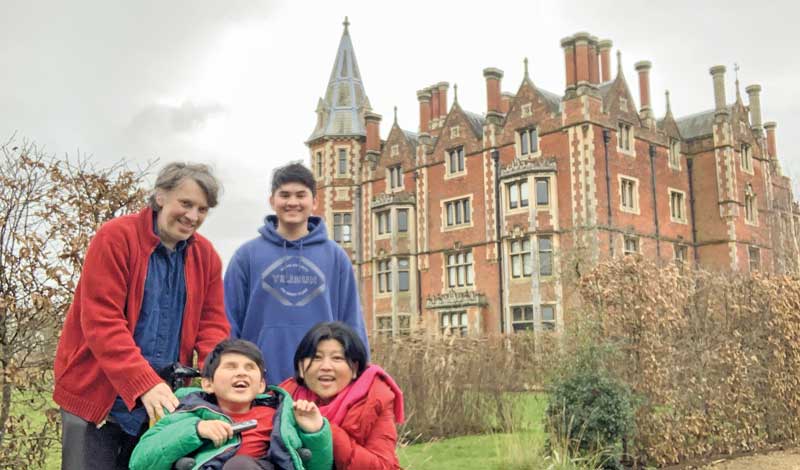
Jason had the operation. How did it go?
Myeong: In the two months leading up to the procedure, I chanted Nam-myoho-renge-kyo every day with the determination that it would be successful and Jason would be able to see. I did my best as a full-time mother and district women’s leader. I also shared Buddhism with others, and every time I did, I felt as if I were reintroducing myself to the power of the Mystic Law. Confidence and strength welled forth from within my life.
On the day of the surgery, February 5, 2013, 30 minutes after the surgery began, the doctor informed us that he opted not to remove the scar tissue on Jason’s left eye because it was attached to the retina and could cause more damage. The nurse also mentioned that when they gave Jason the anesthesia under his tongue, Jason was very resistant. When I heard this, I felt Jason knew that the surgery would not work. Although we had been relying on this procedure for his victory, my Buddhist practice helped me realize that Jason chose this life, and he was carrying out his unique mission for kosen-rufu.
That’s quite a profound realization. How is Jason doing now?
Myeong: Jason is 12 and thriving. He wakes us all up for gongyo in the morning. He’s been doing gongyo since he was 2 and has never skipped a day!
Jason was also born with a genetic condition that causes weak bones, so he has broken his bones several times. But he loves to learn Braille and makes the honor roll every semester at school. In fourth grade, he chanted to have the courage to run for student office and has since been elected secretary, vice president and class president. Recently he was also named “Sixth Grade Boy of the Year.”.
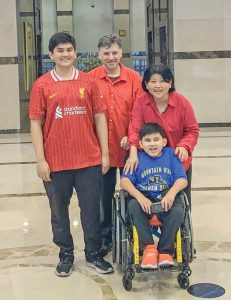
How has Jason’s illness impacted your family?
Myeong: While there are many challenges, we now realize what a benefit Jason’s condition was. He was showing us what it meant to really “open our eyes” based on Buddhism.
It wasn’t about physically being able to see; it was about understanding and “seeing” the deeper meaning of our lives and mission. I understood that regardless of his condition, we could be happy—Jason could be happy. I would say that Jason is the happiest person in our family, bringing joy and laughter wherever he goes.
Our oldest son, Ethan, has always supported Jason wholeheartedly and often brings his own friends to SGI meetings. He’s getting ready to go to college and wants to be an engineer.
What does the word hope mean to you?
Myeong: Hope is knowing that you can overcome every struggle. It is about deciding what you want and sticking with it until you see a victory. Having a mentor is key to generating hope in difficult times. I think about Ikeda Sensei and what he went through. Sensei has overcome everything so I know I can too.
People may look at Jason and feel pity, but Jason’s life is so bright. And he uses his condition to shine even more brilliantly. There are so many individuals who are blind and have been able to accomplish many things, so Jason can do it too. Furthermore, if Jason becomes an example, it opens the way for others to believe that they can do it too. That is his mission.
Jason, do you know that you give hope to many people?
Jason Hasson: No, I didn’t know that.
We heard you share Buddhism with many people. Why do you like to do that?
Jason: When I like someone, I want to share Buddhism with them so that they can attend meetings and become happy. In 2016, I shared Buddhism with my teacher. She received the Gohonzon and took the intro exam!
Where did you learn that spirit to share about your Buddhist practice?
Jason: From my mom.
Myeong: I used to take Ethan and Jason to plant seeds at Fresno State when they were little. I’d tell them, when you sell cookies, you get money, right? But when you share Buddhism, you will gain fortune!
I learned from Sensei that it takes courage to share Buddhism, and when we do, we can break through our own limitations and attachments. Ever since then, I have joyfully shared Buddhism.
What are your determinations for the future?
Jason: I want to be able to walk again and be out of my wheelchair by 2030. I’ll be 17 then! My dream is to attend Soka University of America.
From the September 2025 Living Buddhism
References
- https://www.worldtribune.org/2022/2014-peace-proposal-in-full/ <accessed on July 21, 2025>. ↩︎
- Hope Is a Decision, p. 5. ↩︎
- Ibid. ↩︎
- January 8, 2021, Future Division insert, p. H. ↩︎
- Hope Is a Decision, pp. 4–5. ↩︎
- The New Human Revolution, vol. 26, p. 169. ↩︎
- The Wisdom for Creating Happiness and Peace, part 1, revised edition, p. 255. ↩︎
- You Can Do It, p. 195. ↩︎
- The Writings of Nichiren Daishonin, vol. 1, p. 1003. ↩︎
- “The Opening of the Eyes,” WND-1, 280–81. ↩︎
- https://www.worldtribune.org/2022/2014-peace-proposal-in-full/ <accessed on July 21, 2025>. ↩︎
- Stand Up for Hope and Respect, p. 77.[ref]
This message is especially powerful in troubling times, when young people can feel disillusioned by the world’s complexities and contradictions. Sensei urges the youth to rise to the challenge and lead the way, saying: “Kosen-rufu is achieved through the emergence of a steady stream of youthful Bodhisattvas of the Earth. There is no more meaningful endeavor to which one can dedicate one’s youth. I hope that each of you, the youth division members, will during your youth joyfully strive to leave behind a lasting positive legacy where you are carrying out your mission—a legacy of which you can be proud.”[ref]You Can Do It, p. 76. ↩︎
- Hope Is a Decision, p. 6. ↩︎
You are reading {{ meterCount }} of {{ meterMax }} free premium articles

